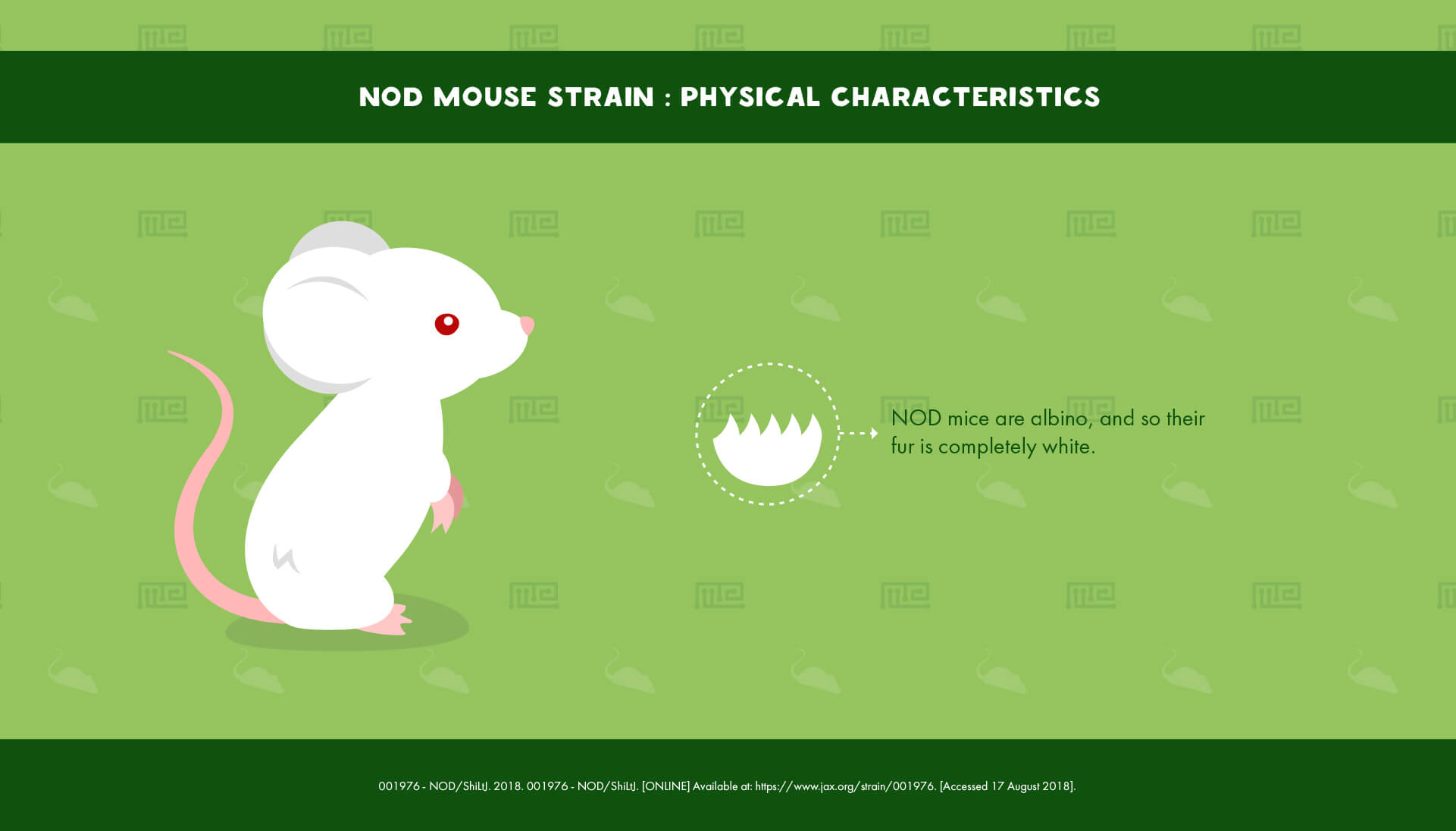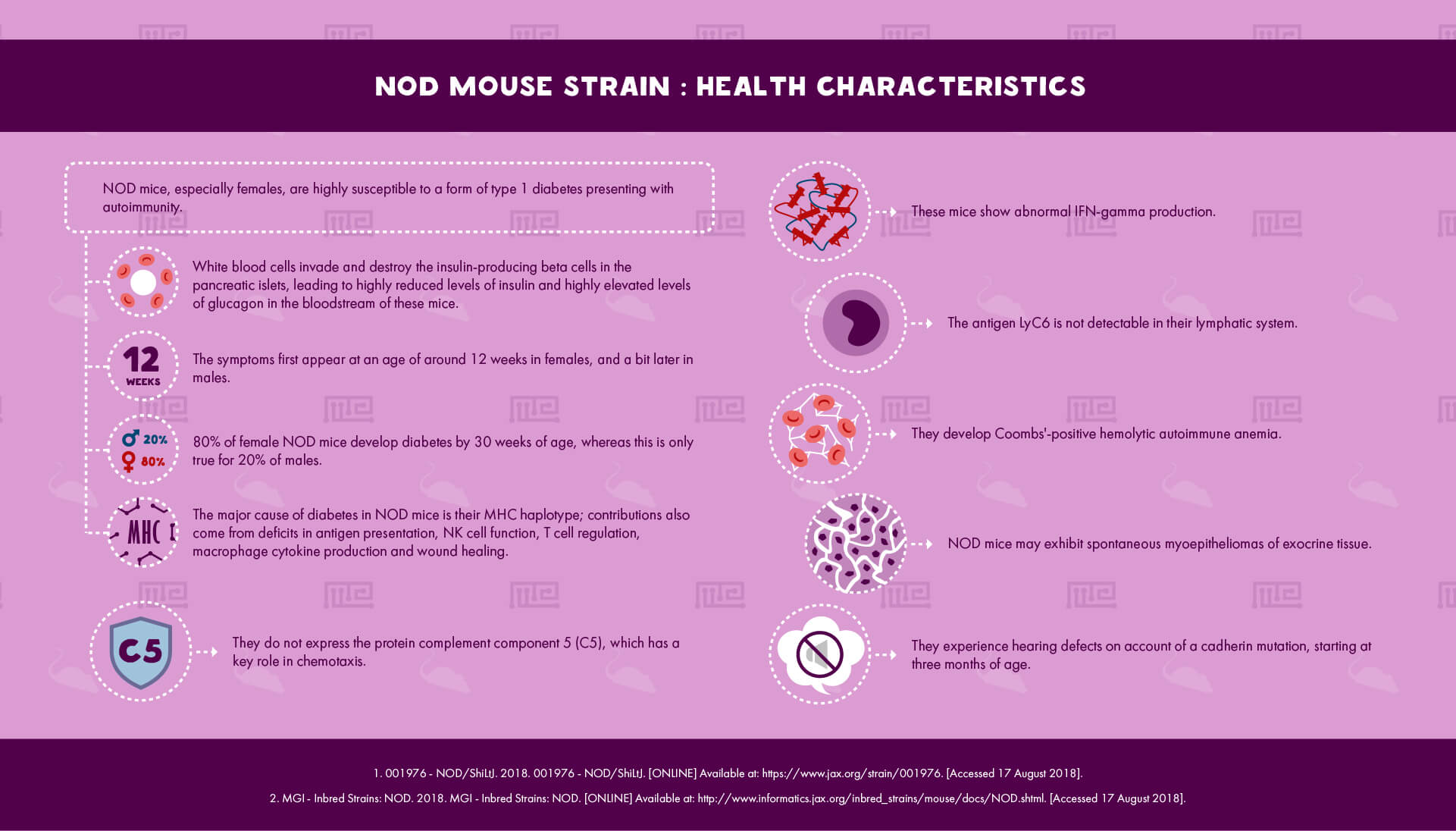Overview
NOD, also known more fully as NOD/ShiLtJ or NOD/LtJ, is an inbred strain of mouse that serves as a very popular model for diabetes research (“NOD” stands for “Non-Obese Diabetic”).
History
The original NOD mice appeared spontaneously during inbreeding of the Cataract Shionogi (CTS) strain in Japan; these mice were inbred in mice without cataracts and selected for high glucose levels during fasting. They were later inbred for normal fasting glucose levels.
Then, in 1974, a mouse of this NOD/Shi strain spontaneously developed diabetes mellitus. The descendants of this female were selectively bred for diabetes, creating the current line of NOD mice. Stock traveled from Japan to the US and Australia in the 1980s. Some came to the Jackson Laboratory, forming the basis of the current NOD(/ShiLtJ) strain.[1][2]
Physical Characteristics
NOD mice are albino, and so their fur is completely white.[1]
Behavioral Characteristics & Handling
Researchers should exercise caution when using NOD mice, bearing in mind that this strain is not the most conducive to easy handling.
A Canadian study comparing the ease of handling of 21 commonly used mouse strains reports that NOD mice showed relatively low placidity, with significantly higher amounts of evasion during capture, and struggling when held than strains like BALB/cByJ and C57BL/6J. Squeaking frequency was intermediate.[3]
One study using the elevated plus maze test suggests that NOD mice exhibit complex differences in anxiety compared to the C57BL/6J strain, following oral gavage and sham EAE induction.[4] They have a slightly higher sucrose preference than other strains.[5] NOD mice have also shown average performance in the Morris water maze, about the same as C57BL/6J and better than BALB/cByJ.[6]
Health Characteristics
NOD mice, especially females, are highly susceptible to a form of type 1 diabetes presenting with autoimmunity. White blood cells invade and destroy the insulin-producing beta cells in the pancreatic islets, leading to highly reduced levels of insulin and highly elevated levels of glucagon in the bloodstream of these mice.[1][2]
The symptoms first appear at an age of around 12 weeks in females, and a bit later in males. 80% of female NOD mice develop diabetes by 30 weeks of age, whereas this is only true for 20% of males. The diabetes is polygenic and highly sensitive to environmental conditions. Housing, diet and general health can all have a marked effect on disease development.[1][2]
The major cause of diabetes in NOD mice is their MHC haplotype; contributions also come from deficits in antigen presentation, NK cell function, T cell regulation, macrophage cytokine production and wound healing. They also do not express the protein complement component 5 (C5), which has a key role in chemotaxis.[1]
In addition to their diabetes, the many genetic abnormalities of NOD mice have led to other deficiencies in their immune function: IFN-gamma production is abnormal, the antigen LyC6 is not detectable in their lymphatic system, and they develop Coombs’-positive hemolytic autoimmune anemia.[1][2]
NOD mice may occasionally exhibit spontaneous myoepitheliomas of exocrine tissue. They also experience hearing defects on account of a cadherin mutation, with defects starting at three months of age.[1]
Major Experimental Uses
NOD mice are a very popular laboratory model for type I diabetes mellitus and other autoimmune conditions. Females are much more frequently used than males due to their greater penetrance and intensity of diabetic and autoimmune symptoms.[1][2] At present, work is being undertaken to “humanize” NOD mice and make them a more accurate model.[7]
Male NOD mice are more useful for pharmacological applications. The strain is also used in research on lymphatic deficits, wound healing and hearing defects.[1]
References
- 001976 – NOD/ShiLtJ. 2018. 001976 – NOD/ShiLtJ. [ONLINE] Available at: https://www.jax.org/strain/001976. [Accessed 17 August 2018].
- MGI – Inbred Strains: NOD. 2018. MGI – Inbred Strains: NOD. [ONLINE] Available at: http://www.informatics.jax.org/inbred_strains/mouse/docs/NOD.shtml. [Accessed 17 August 2018].
- Wahlsten, D. Metten, P. Crabbe, JC. 2003. A rating scale for the wildness and ease of handling laboratory mice: results for 21 inbred strains tested in two laboratories. Genes, Brain and Behavior. 2; 71-79.
- Pece Kocovski, Phuc T. Dang, Claretta S. D’Souza, Christopher E. Stamper, Matthew W. Hale, and Jacqueline M. Orian. Differential anxiety-like responses in NOD/ShiLtJ and C57BL/6J mice following experimental autoimmune encephalomyelitis induction and oral gavage. Laboratory Animals. February 14, 2018.
- Poole, R. L., Aleman, T. R., Ellis, H. T., & Tordoff, M. G. (2016). Maltodextrin Acceptance and Preference in Eight Mouse Strains. Chemical Senses, 41(1), 45–52.
- Wahlsten, D., Cooper, S.F., and Crabbe, J.C. (2005) Different rankings of inbred mouse strains on the Morris maze and a refined 4-arm water escape task. Behavioural Brain Research, 165: 36-51.
- Pearson, J. A., Wong, F. S., & Wen, L. (2016). The importance of the Non Obese Diabetic (NOD) mouse model in autoimmune diabetes. Journal of Autoimmunity, 66, 76–88. http://doi.org/10.1016/j.jaut.2015.08.019


